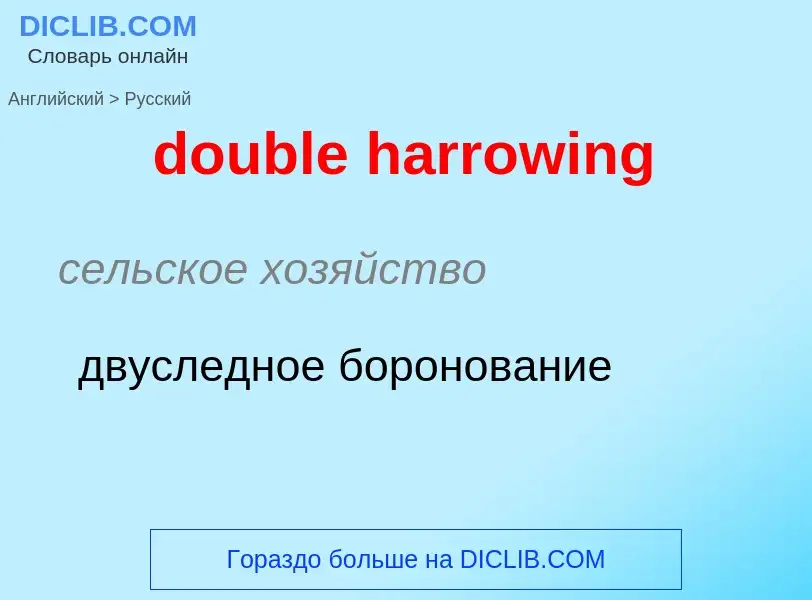Перевод и анализ слов искусственным интеллектом ChatGPT
На этой странице Вы можете получить подробный анализ слова или словосочетания, произведенный с помощью лучшей на сегодняшний день технологии искусственного интеллекта:
- как употребляется слово
- частота употребления
- используется оно чаще в устной или письменной речи
- варианты перевода слова
- примеры употребления (несколько фраз с переводом)
- этимология
double harrowing - перевод на русский
сельское хозяйство
двуследное боронование
общая лексика
двойное действие
['du:blɑ:ŋ'tɑ:ŋdr]
общая лексика
двойной смысл
двусмысленность
двусмысленное слово или выражение
существительное
Франция
двусмысленное выражение, двусмысленность
существительное
общая лексика
двоякое значение
двусмысленность
[dʌbl'ækʃ(ə)n]
прилагательное
военное дело
самовзводный
синоним
существительное
['dʌblækʃ(ə)n]
музыка
механика с двойной репетицией
Определение
Википедия

In agriculture, a harrow is a farm implement used for surface tillage. It is used after ploughing for breaking up and smoothing out the surface of the soil. The purpose of harrowing is to break up clods and to provide a soil structure, called tilth, that is suitable for planting seeds. Coarser harrowing may also be used to remove weeds and to cover seed after sowing.
Harrows differ from ploughs, which cut the upper 12 to 25 centimetre (5 to 10 in) layer of soil, and leave furrows, parallel trenches. Harrows differ from cultivators in that they disturb the whole surface of the soil, while a cultivator instead disturbs only narrow tracks between the crop rows to kill weeds.
There are four general types of harrows: disc harrows, tine harrows (including spring-tooth harrows, drag harrows, and spike harrows), chain harrows, and chain-disk harrows. Harrows were originally drawn by draft animals, such as horses, mules, or oxen, or in some times and places by manual labourers. In modern practice they are almost always tractor-mounted implements, either trailed after the tractor by a drawbar or mounted on the three-point hitch.
A modern development of the traditional harrow is the rotary power harrow, often just called a power harrow.

![A [[spring-tooth drag harrow]] A [[spring-tooth drag harrow]]](https://commons.wikimedia.org/wiki/Special:FilePath/12 foot spring-tooth drag harrow.jpg?width=200)


.jpg?width=200)
![A poster advertising [[American International Pictures]]' double feature of ''[[Die, Monster, Die!]]'' and ''[[Planet of the Vampires]]''. A poster advertising [[American International Pictures]]' double feature of ''[[Die, Monster, Die!]]'' and ''[[Planet of the Vampires]]''.](https://commons.wikimedia.org/wiki/Special:FilePath/AIP double feature.jpg?width=200)
![[[The Astor Theatre]] in [[Melbourne]], [[Australia]] has shown double features since its opening in 1936. [[The Astor Theatre]] in [[Melbourne]], [[Australia]] has shown double features since its opening in 1936.](https://commons.wikimedia.org/wiki/Special:FilePath/Astor theatre st kilda.jpg?width=200)

![[[Mae West]] was famous for her risqué double entendres [[Mae West]] was famous for her risqué double entendres](https://commons.wikimedia.org/wiki/Special:FilePath/Mae West LAT.jpg?width=200)
![Michael Scott]] (played by [[Steve Carell]], pictured) often points out unintentional double entendres with the phrase "[[that's what she said]]" Michael Scott]] (played by [[Steve Carell]], pictured) often points out unintentional double entendres with the phrase "[[that's what she said]]"](https://commons.wikimedia.org/wiki/Special:FilePath/Steve Carell November 2014.jpg?width=200)
![The first page of the poem "The Wanderer" found in the [[Exeter Book]]. The first page of the poem "The Wanderer" found in the [[Exeter Book]].](https://commons.wikimedia.org/wiki/Special:FilePath/Wanderer-Exeter-Book-first-page-Bernard-Muir.jpg?width=200)

